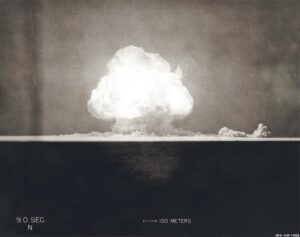Through my work on several National Academy of Sciences committees I’ve come to appreciate the lasting effects of the Manhattan Project on tribal lands—and the peoples who lived there. Several sites around the United States helped develop and produce nuclear weapons during the Manhattan Project and the Cold War. To make an atomic weapon you need to extract and refine uranium. The Belgian Congo produced the purest uranium ore. However, German U-boats made it risky to ship across the Atlantic. At the same time, improvements in uranium refining technology made it more economical to use domestic sources. The yellow dirt of the American Southwest became an important source of uranium for the Manhattan Project and the Cold War. This yellow dirt has left its mark on the Navajo Nation.

Yellow dirt
Judy Pasternak’s book, Yellow Dirt: A Poisoned Land and the Betrayal of the Navajos, tells how uranium mining left a legacy of contamination—and cancer—for the Navajo Nation. It arose from her reporting for the Los Angeles Times.
At the Los Alamos, NM, site and the surrounding area, mining and refining uranium required workers. Lacking other job opportunities, the Navajo Nation provided much of this labor force. But because there was little control over the dust from mining and processing the yellow dirt, workers were directly exposed. They also brought yellow dirt home on their clothing, exposing their families. Anyone who lived downwind also received radiation exposure. Some, lacking the resources for building materials, used the uranium ore to build their homes.
At the time of the Manhattan Project we didn’t know a lot about radiation and illness. Before WWII, many consumer products contained radioactive materials. For example, Fiesta Ware dinner plates had a uranium-bearing glaze. The red glaze was the most highly radioactive. Production of the radioactive plates stopped during the war to free up uranium for nuclear weapons and resumed after the war.
However, the need for proper industrial hygiene for uranium miners was known before WWII. More than a decade earlier, research had attributed lung cancer to breathing yellow dirt. Lung cancer and stomach cancer, both previously rare among the Navajo, became much more common in the 1960s, as did asthma.
Video: PBS Newshour: lingering health effects of uranium mining on Indigenous peoples of the Southwest.
Church Rock spill
The Church Rock uranium mill, about 20 miles north of Gallup, NM, is near Navajo land. In July 1979 it became the site of the largest release of radioactive material ever in the US. Radioactive mine tailings were stored in ponds on the site. The concrete dam on one of the ponds burst, spilling the contents into the Pipeline Arroyo, a tributary of the Rio Puerco. A total of 1100 tons of solid radioactive waste and 93 million gallons of liquid waste entered the river, contaminating it and numerous wells in the area. Radioactivity in the water reached as high as 7000 times the legal limit for safe drinking water.
Unlike the accident at Three Mile Island in the same year, this one still hasn’t been cleaned up despite being a much larger release of radioactive material. In the immediate aftermath, children who swam in the river downstream from the spill suffered radiation burns and animals that drank the water died. The long-term health effects are still playing out.
Video: A massive spill of radioactive contamination on Navajo lands.
